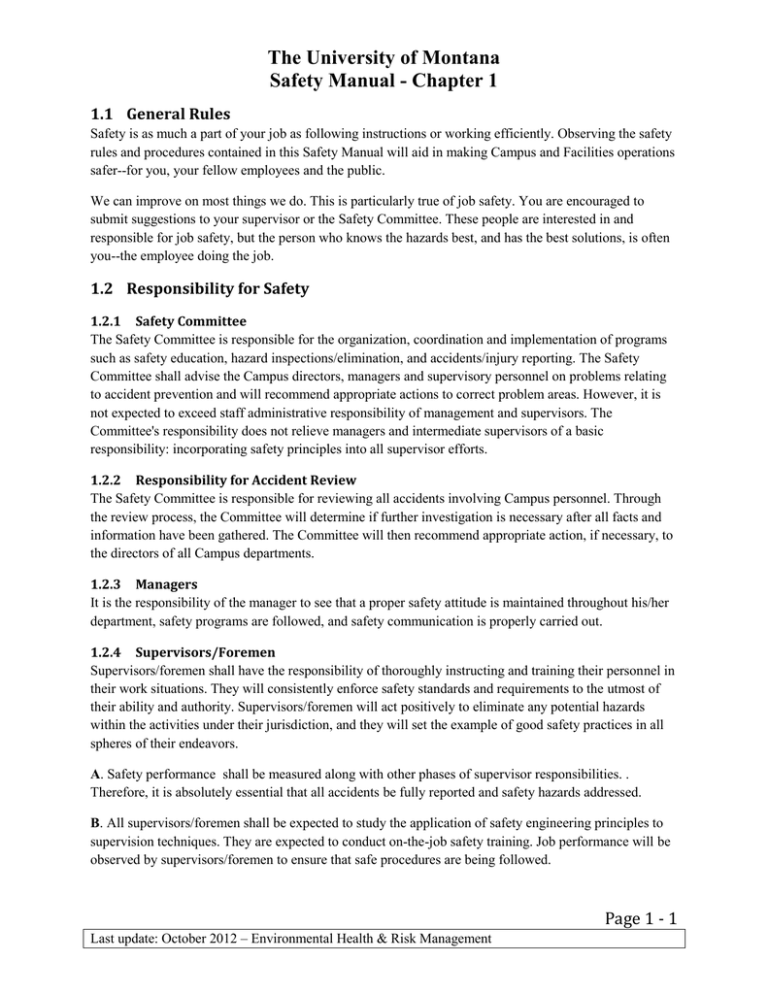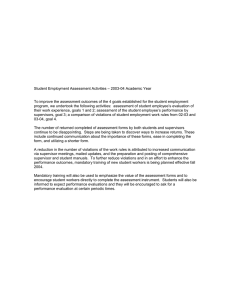The University of Montana Safety Manual - Chapter 1
advertisement

The University of Montana Safety Manual - Chapter 1 1.1 General Rules Safety is as much a part of your job as following instructions or working efficiently. Observing the safety rules and procedures contained in this Safety Manual will aid in making Campus and Facilities operations safer--for you, your fellow employees and the public. We can improve on most things we do. This is particularly true of job safety. You are encouraged to submit suggestions to your supervisor or the Safety Committee. These people are interested in and responsible for job safety, but the person who knows the hazards best, and has the best solutions, is often you--the employee doing the job. 1.2 Responsibility for Safety 1.2.1 Safety Committee The Safety Committee is responsible for the organization, coordination and implementation of programs such as safety education, hazard inspections/elimination, and accidents/injury reporting. The Safety Committee shall advise the Campus directors, managers and supervisory personnel on problems relating to accident prevention and will recommend appropriate actions to correct problem areas. However, it is not expected to exceed staff administrative responsibility of management and supervisors. The Committee's responsibility does not relieve managers and intermediate supervisors of a basic responsibility: incorporating safety principles into all supervisor efforts. 1.2.2 Responsibility for Accident Review The Safety Committee is responsible for reviewing all accidents involving Campus personnel. Through the review process, the Committee will determine if further investigation is necessary after all facts and information have been gathered. The Committee will then recommend appropriate action, if necessary, to the directors of all Campus departments. 1.2.3 Managers It is the responsibility of the manager to see that a proper safety attitude is maintained throughout his/her department, safety programs are followed, and safety communication is properly carried out. 1.2.4 Supervisors/Foremen Supervisors/foremen shall have the responsibility of thoroughly instructing and training their personnel in their work situations. They will consistently enforce safety standards and requirements to the utmost of their ability and authority. Supervisors/foremen will act positively to eliminate any potential hazards within the activities under their jurisdiction, and they will set the example of good safety practices in all spheres of their endeavors. A. Safety performance shall be measured along with other phases of supervisor responsibilities. . Therefore, it is absolutely essential that all accidents be fully reported and safety hazards addressed. B. All supervisors/foremen shall be expected to study the application of safety engineering principles to supervision techniques. They are expected to conduct on-the-job safety training. Job performance will be observed by supervisors/foremen to ensure that safe procedures are being followed. Page 1 - 1 Last update: October 2012 – Environmental Health & Risk Management The University of Montana Safety Manual - Chapter 1 C. When accidents occur, supervisors/foremen will investigate them for the purpose of fact finding. The objective is to determine how and why the accident happened so that it can be prevented from happening again. 1.2.5 Employees All employees are responsible for compliance with safety procedures, standards and rules outlined in this manual, or other applicable directives, established to prevent injury to themselves, other persons or damage to equipment and property. Employees are also responsible for promptly reporting to their supervisors any hazardous condition or procedure that affects them, their fellow workers or the general public. Employees are responsible for verbally reporting accidents and injuries to their supervisors immediately and working with them to provide written reports within 24 hours. 1.3 General Safety Rules (Using "SR" as an abbreviation for "Safety Rule") SR 1.3.1 Report all personal injuries, no matter how minor, to your immediate supervisor/foreman as soon as possible and fill out all required forms. This must be done whether or not the injury resulted in lost time from work or required medical attention. Prompt reporting of accidents is a requirement under Federal and State OSHA Laws and the Worker's Compensation Law. Supervisors, in conjunction with the injured employee, must complete the Worker's Compensation First Report of Injury Form within 24 hours. All serious injuries requiring immediate medical attention will be reported to the Directors of Campus and Facilities Services as soon as possible. SR 1.3.2 Do not engage in horseplay and practical jokes on the job. SR 1.3.3 Drinking of alcoholic beverages, use of illegal drugs and the excessive use or abuse of prescription drugs, on the job or during assigned work hours, is prohibited. If you are required to take medication during the work hours, you may be asked to produce a written medical statement stating that the medication will not adversely affect your decision making or physical abilities. SR 1.3.4 Immediately report any recognized potentially unsafe condition or act to your supervisor. SR 1.3.5 Observe and obey the warning and safety signs that are displayed throughout the University. They are posted for your protection and to point out hazards. SR 1.3.6 Operate only the machinery or equipment you have been authorized and trained to operate safely. SR 1.3.7 Speed limits on the University property must be strictly observed at all times by all vehicles. SR 1.3.8 Wear personal protective equipment as required. Page 1 - 2 Last update: October 2012 – Environmental Health & Risk Management The University of Montana Safety Manual - Chapter 1 1.4 General Safety Procedures 1.3.1 Before beginning work, notify your supervisor of any permanent or temporary impairment that may reduce your ability to perform in a safe manner. 1.3.2 Campus and Facilities Services does not expect you to take any unnecessary chances to work under hazardous conditions. Learn the right way to do your job. That will be the safe way. If you are not sure you thoroughly understand the job, ask your supervisor/foreman for further instruction. 1.3.3 Work at a speed consistent with safety. "FOOLISH HURRYING" such as running in passage ways or on stairs is dangerous. 1.3.4 Keep yourself in good physical condition. 1.3.5 Jumping from an elevation such as a table, bench or platform is liable to result in serious injury. 1.3.6 Always inspect tools and equipment before use. Report defects to supervisor/foreman and other potential users. Do not use unsafe tools and equipment. 1.4.7 Do not enter a confined space unless properly trained and authorized to do so. 1.4.8 Do not under any circumstances use an air hose for personal cleaning. 1.4.9 Do not carry passengers on a forklift unless in an approved safety cage. 1.4.10 Work clear of suspended loads; if a load is moved above where you are working, stand aside until it has passed. 1.3.11 Never operate machinery or equipment with guards removed. 1.3.12 Report to work in clothing suitable for the type of work you perform. This includes footwear. Avoid wearing loose clothing or personal equipment near machinery or equipment with moving parts. Clothing should provide adequate protection for hazards of weather and chemical and material irritants. 1.3.13 Never park vehicles or equipment under power lines at the scene of a fire or other disaster or at the scene of construction activities unless that is the only position from which the equipment may perform the required job. If that is the case, take additional precautions as outlined in other sections. NOTE: The telephone numbers for campus emergencies are 4000 and/or 9-911. Page 1 - 3 Last update: October 2012 – Environmental Health & Risk Management





